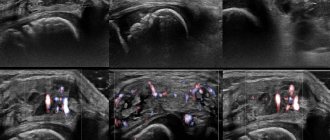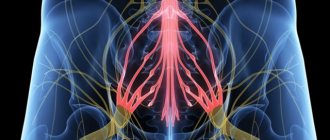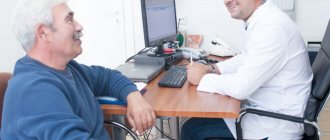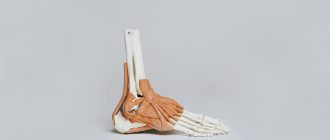What is a hypermobile joint
The joint allows movement, but it is limited by the tendons and ligaments surrounding the joint. When the ligaments work normally, they allow, for example, bending the arm at the elbow. With hypermobility, a person can bend his arm in the other direction. This already indicates weak ligaments.
Hypermobility can be congenital or acquired. Thus, athletes involved in certain sports, ballet and circus performers also have excessively mobile joints, but this is usually the result of hard training. Although, on the other hand, congenital hypermobility of the joints is often the reason for choosing these particular professions.
In fact, there are quite a lot of people with hypermobile joints, according to some data – about 15%. But not everyone is diagnosed with this syndrome, since a person does not perceive this peculiarity as a pathology and does not seek medical help.
Physical education, but not any
Treating pain in joint hypermobility with non-steroidal anti-inflammatory drugs (NSAIDs), as is done, for example, with arthrosis, is pointless, since the pain in this case is not caused by inflammation, but by another reason. It is preferable to use analgesics, although drug treatment in this case is far from the main thing. For persistent pain, it is rational to use elastic orthoses (knee pads) and bandages.
The patient will also have to eliminate loads that cause pain and discomfort in the joints, especially for team sports. Jumping, gymnastics and wrestling are prohibited. But swimming is very useful - it harmoniously develops muscles, but most importantly, it does not overload the joints, since body weight is less in water.
Special exercise therapy (isometric gymnastics) is also necessary. Although, unfortunately, it cannot be used to remove excessive stretchability of the ligaments, it can strengthen the muscles surrounding the painful joint or area of the spine. A strong muscle frame will take over the function of the ligaments, helping to stabilize the joint. Depending on the area of the body that hurts, you should choose the distribution of the load: either strengthen the thigh muscles, or work on the muscles of the shoulder girdle, back, etc.
Yoga can help with hypermobility syndrome, namely: static fixations of the body shape (asanas), which improve blood circulation in the joint capsule and strengthen the connective tissue of the joint, eliminating its excessive looseness, but without limiting normal mobility.
If any orthopedic abnormalities are detected, the patient is prescribed special gymnastics, orthopedic insoles, and in advanced situations, surgical treatment.
If the pain is accompanied by inflammation in the periarticular tissues, ointments and gels with NSAIDs will be needed, as well as local or injection administration of drugs that suppress inflammation.
What are the causes of hypermobility?
It is believed that this condition of the periarticular tissues is caused by excessive extensibility of collagen, a connective tissue protein that forms the basis of ligaments and tendons.
In some cases, hypermobility is a symptom of genetically determined connective tissue diseases, such as Ehlers-Danlos syndrome, Marfan syndrome. But such diseases are rare. More often the syndrome is associated with connective tissue weakness. Typically, this condition is inherited through the female line.
It's all about collagen
By the way, it is believed that this pathology occurs predominantly in female faces. Its prevalence is 5–7% of the total population, but every year the number of gutta-percha women and men is growing. This syndrome is more common among eastern peoples. There are especially many “rubber” people living in Asia, a little less of them in Africa and much less in Europe.
In some families, unusual stretch marks are inherited. But despite the fact that not in all cases people with snake-like flexibility need treatment, sometimes excessive stretchability of the ligaments can lead to problems.
The disease we are talking about today is a consequence of weakness of the ligamentous apparatus. And the reason for this phenomenon lies in molecular changes within the main structural protein of the body - collagen. The same protein is part of the skin, hair, nails, and it also makes up the walls of blood vessels and ligaments that support internal organs (it is due to these “suspensions” that the liver, kidneys, uterus and other organs can occupy the physiologically correct location in the body).
With a gross genetic mutation that disrupts the synthesis of collagen in the body, a person may experience severe, but, fortunately, rare hereditary diseases, in which patients experience excessive flexibility of the joints, and also in the first case, multiple bone fractures, and in the second - very tensile skin and the possibility of spontaneous rupture of blood vessels.
With joint hypermobility syndrome, the situation is less sad, but unpleasant consequences also exist. The altered protein impairs the firmness and elasticity of the ligamentous apparatus, as a result of which the ligament overstretches and becomes flaccid during the movement of the joint. Unfortunately, changes in the molecular structure of collagen in people with joint hypermobility syndrome are inherited and persist for life.
Since almost no system of the body can function without the participation of collagen, there can be many diseases associated with the weakness of connective tissue structures. This includes the early appearance of wrinkles, prolapse of heart valves (excessive sagging of the valves), prolapse of internal organs, and varicose veins. But most often, patients with joint hypermobility have problems with the joints and spine. In particular, this pathology can be considered a risk factor for the development of arthrosis.
What are the dangers of hypermobile joints?
It would seem that there is nothing wrong with the fact that the joints can easily bend in different directions. But the fact is that the consequences of such hyper-mobility can be quite sad.
- People with joint hypermobility often suffer injuries such as dislocations and sprains, especially ankle sprains.
- After minor injuries and even ordinary physical activity, the joints begin to ache. The ankle and knee joints are the most vulnerable.
- Often an inflammatory process develops in the joint membrane - bursitis, synovitis, etc.
- People with hypermobile joints develop osteoarthritis in their young years.
- They suffer from back pain.
- A common consequence of the syndrome is scoliosis (curvature of the spine).
- Another consequence of hypermobility of the joints is flat feet.
By the way
With the syndrome of “loose” joints, the issue of professional guidance arises especially acutely. Work associated with physical overexertion, long walking or long standing is dangerous for the patient. In these cases, the weak, stretched connective tissue part of the joint (ligaments, capsule) cannot withstand the load, and it “looses,” which contributes to the development of arthrosis. Despite the natural amazing flexibility, which seems to naturally push a person to practice choreography, you should categorically not become a dancer or ballerina with this syndrome - otherwise you may remain disabled.
How are hypermobile joints identified?
To diagnose hypermobility syndrome, the Beighton scale is used, based on assessing the mobility of various joints. The patient is asked to perform several movements, the results of which are awarded points.
1. Bend the little finger on your hand back with the help of your other hand (passive movement). The same is repeated with the other hand.
If you manage to bend your finger more than 90 degrees, 1 point is awarded for each hand.
2. Bend your thumb (also with the help of your other hand) and try to touch the area under the wrist. The same thing with the other hand. When touching - 1 point for each hand.
3. Reextend your arm at the elbow joint. The same thing with the other hand. For extension of more than 10 degrees – 1 point for each arm.
4. Re-extend the leg at the knee joint. When extension is more than 10 degrees - 1 point for each leg.
5. Standing with your knees fully straightened, bend over and touch your palms to the floor - 1 point.
In total you can get 9 points. Joint hypermobility is confirmed if a person scores 4 points or more.
Of course, this approach is very simplified and does not take into account either the age or gender of the patient, however, as a first approximation, this method allows us to talk about the presence of hypermobility syndrome.
Hypermobility syndrome
Hypermobility of joints, or increased mobility, is identified as an independent nosological form, which was reflected in the domestic “Working Classification and Nomenclature of Rheumatic Diseases” of 1988. This form appears there in section XIII “Arthropathy in non-rheumatic diseases”, paragraph 3 “Congenital defects of connective tissue metabolism” together with Marfan and Ehlers-Danlos syndromes and mucopolysaccharidoses. The 1983 American Rheumatology Association classification does not mention joint hypermobility. Isolating it as an independent unit is evidence of progress in the study of this form and the urgent need to draw the attention of practitioners to it.Joint hypermobility is defined as an excess of range of motion in one or more joints compared to the average. And although this condition was described by our compatriot A. Chernogubov more than 100 years ago and has been intensively studied over the past 30 years, the question of what should be taken as the average statistical norm of range of motion and what should be classified as hypermobility has not been finally resolved. This is especially difficult to determine in children, since they are characterized by physiological hypermobility due to the immaturity of connective tissue.
For an objective assessment of the state of joint mobility, various researchers have proposed diagnostic criteria. The most popular of them are the Carter and Wilkinson criteria as modified by Beighton.
Criteria for joint hypermobility.
1. Passive flexion of the metacarpophalangeal joint of the 5th finger in both directions; 2. Passive flexion of the 1st finger towards the forearm while flexing at the wrist joint; 3. Hyperextension of the elbow joint over 10°; 4. Hyperextension of the knee joint over 10°; 5. Bend forward with the knee joints fixed, with the palms reaching the floor.
Three of these symptoms must be present to establish hypermobility. Scoring is also used: 1 point means pathological hyperextension on one side of one joint. The maximum value of the indicator, taking into account two-way localization, is 9 points (8 for the first 4 points and 1 for the 5th point). An indicator from 3 to 9 points is regarded as a state of hypermobility, up to 2 points - as a variant of the norm.
For the purpose of more detailed characteristics, a graduated scoring of movements in each joint is used - from 2 to 6-7 points. In normal practice, it is rarely used, as are methods using various devices.
Prevalence
Epidemiological studies using clinical tests have established widespread hypermobility in 10 percent. representatives of the European population and 15-25 percent. - African and Asian. According to M. Ondrasik, who examined the Slovak population aged 18-25 years (1299 people), a mild degree of hypermobility (3-4 points according to Beighton) occurred in 14.7 percent, severe (5-9 points) - in 12 percent. .5 percent, generalized (in all joints) - in 0.7 percent. That is, increased joint mobility was found in almost 30 percent. of the examined young people, the ratio of females and males was the same. In other studies, women predominated in varying ratios to men - 6:1 and even 8:1.
Among the children examined, increased joint mobility was detected in various studies in 2-7 percent. The following general patterns have been established: in children in the first weeks of life, articular hypermobility cannot be detected due to muscle hypertonicity; it occurs in almost 50 percent. children under 3 years of age, at 6 years of age it is determined in 5 percent, and at 12 years of age - in 1 percent. (in at least three paired joints). In young children, this syndrome occurs with equal frequency in boys and girls, and in puberty - more often in girls. The decrease in the number of people with increased joint mobility occurs quickly in childhood as the child grows and connective tissue matures; the slowdown peaks after the age of 20 years.
Clinic
Joint hypermobility can be one of the clinical signs of hereditary connective tissue diseases, such as Ehlers-Danlos syndrome, Marfan syndrome and more rare disorders of amino acid metabolism - homocystinuria, hyperlysinemia; also occurs in other rare syndromes - Achard, Stickler, Larsen, Leopard and some others.
Secondary joint hypermobility can develop in any inflammatory process with articular localization due to weakening of the capsule and ligaments. It has been recorded in some neurological, endocrine diseases, etc.
Thus, articular hypermobility, on the one hand, can be a physiological phenomenon at a certain age or on the verge of physiological, if it is not of a generalized and pronounced nature. On the other hand, it represents a pathological phenomenon leading to disruption of the musculoskeletal system and is called “hypermobility syndrome”. And finally, hypermobility is the main clinical manifestation of the joints in the mentioned hereditary connective tissue diseases, and the degree of hypermobility in individual patients may not exceed the upper limit of the average norm and be non-generalized. Since hypermobility syndrome is sometimes accompanied by damage not only to joints, but also to other organs and systems, it is difficult, and sometimes impossible, to draw a clear boundary and differentiate between these conditions. For this reason, and also taking into account the genetic aspects and the results of some morphological studies of the fibrous structures of connective tissue, some researchers, in particular Graham, who has been studying this problem for more than 30 years, believe that joint hypermobility syndrome and Ehlers-Danlos and Marfan syndromes belong to the same group hereditary diseases located at opposite ends of the clinical spectrum.
Many other authors, in particular T. Milkovska-Dmitrova and A. Karakashov, share a similar opinion. They combine these conditions with the single term “congenital connective tissue deficiency” (“low resistance” in Bulgarian) and regard it as a single condition with a heterogeneous clinical picture, distinguishing two main forms: polysymptomatic and oligosymptomatic. The first is the most severe, sometimes leading to death. It identifies signs of damage to the connective tissue of many organs and systems. The Ehlers-Danlos and Marfan syndromes belong to the multisystem category.
The oligosymptomatic form is much more common and is characterized by less pronounced and less generalized symptoms. This group also includes hypermobility syndrome.
T. Milkovska-Dmitrova and A. Karakashov also consider certain types of congenital inferiority of connective tissue, depending on the predominant localization in a particular system. They identified the following forms: articular, ocular, ecchymotic, pulmonary, laxative, renal, cardiovascular, periodontal, mitral valve prolapse, abdominal, scoliotic.
Here is a brief description of them.
Damage to the osteoarticular system is the most common location. Various anomalies of skeletal development are observed: irregular shape of the skull, Gothic palate, slow growth of the upper and lower jaw (“bird face”), funnel chest and other deformations of the chest, long fingers on the hands, curvature and shortening of them, asymmetry in the length of the limbs, violation body growth.
As a consequence of weakness of the ligamentous apparatus, hyperlaxation develops in all or several joints - the most common symptom: the ability to perform exercises that require unusual flexibility (“bridge”, “lotus”, “splits”, scratching behind the ear with toes, etc.). Subluxations and dislocations of the arms, hip joints, and, less commonly, wrist and shoulder joints are common, as well as recurrent distortion of the ankle joints. Incorrect posture, kyphosis, hyperlordosis, discopathy are formed; with asymmetry of the lower extremities - scoliosis; Flat feet, genu recurvatum, hallux valgus, etc. develop.
A typical complaint is pain, often in the lower extremities, mainly after a long walk, during active sports, or during physical overexertion. The pain mainly occurs at the end of the day, rarely in the morning. Small children complain of fatigue and ask to be held. There are pains in the hip joints, along the spine.
With severe hypermobility, post-traumatic arthritis is possible, localized mainly in the most loaded joints of the legs (knees and ankles); they can also occur in the wrist and interphalangeal joints of the hands. According to M. Ondrasik, it occurred in 7 percent. patients with hypermobility syndrome in adults and imitated rheumatoid and chronic arthritis in a number of patients. According to B. Ansell, in children and adolescents, episodes of recurrent synovitis of post-traumatic origin due to hypermobility are mild. The composition of the synovial fluid and the histological picture of the synovial membrane - without signs of severe inflammation. Arthritis is eliminated quickly, without residual effects.
Weakness of the ligaments and joint capsule can lead to premature degenerative changes in the cartilage of the joints - the formation of early osteoporosis. This is facilitated by tenosynovitis, ruptures of ligaments, muscles, and joint capsule, which easily occur in patients with defective connective tissue. In them, pyrophosphates are more easily deposited in the joints, which aggravates degenerative processes. Chondromalacia of the patella and protrusion of the acetabular cavity are possible. Weakness of the spinal ligaments leads to damage to the vertebrae and discs with the formation of chronic vertebrogenic syndromes. Night pain, mainly in the area of the sacroiliac joints, can simulate sacroiliitis in ankylosing spondylitis.
Skin lesions are characterized by increased extensibility (more than 5 cm in the elbow area, neck, chest), it is pale, soft, with multiple parchment-like scars, and is easily vulnerable. Pigmented and depigmented spots and freckles are characteristic. There are pseudotumors on the elbows, knees, and heels. On the legs, small nodules under the skin are visible - abnormalities in the growth of adipose tissue (subcutaneous spherules). There may be webbing between the fingers, deformation of the ears, epicanthus, and hanging uvula. Ecchymoses, hematomas of various locations, bleeding from the nose, gums, gastrointestinal tract, uterus, etc. easily occur; ruptures of the aorta and other large vessels are possible.
Cardiovascular manifestations occur quite often - according to various authors, in more than 60 percent. patients with hereditary connective tissue diseases. These are congenital defects of the heart and blood vessels - arterial and venous, including varicose veins. Very often, especially with the Ehlers-Danlos and Marfan phenotypes, mitral valve prolapse (MVP) and various heart rhythm disturbances are diagnosed. The frequency of MVP reaches 50-70% in congenital connective tissue deficiency. According to M. Ondrasik, 50% of adults with MVP exhibit joint hypermobility. In children, auscultation-determined MVP correlates with a high degree of stigmatization of patients. The clinical manifestations of these conditions are well known to practicing physicians.
Eye anomalies: blue sclera, strabismus, increased mobility of the eyeballs, luxation and ectopia of the lens, hypertelorism, hyper- and hypometropia, glaucoma, hyperelasticity of the skin of the eyelids, epicanthus. Many of the eye symptoms progress with age.
Respiratory system: tracheobronchomegaly, spontaneous pneumothorax, emphysema, recurrent bronchopneumonia, obstructive bronchitis.
Gastrointestinal tract: hernias, diverticulosis of the stomach and intestines, enlargement of its individual parts, ptosis of internal organs, perforation, bleeding.
Genitourinary system: anomalies, polycystic disease, bladder diverticulosis. A combination of hereditary diseases of the genitourinary system with multiple signs of dysembryogenesis of connective tissues is shown. Interestingly, in congenital and hereditary diseases of the genitourinary system, HLA-B35 (as a genetic marker) is detected more often than others. It was also discovered by M. Ondrasik in patients with joint hypermobility.
Teeth: abnormal location, irregular formation, enamel hypoplasia, gum resorption, tooth loss, multiple caries, etc.
Neurovegetative manifestations and mental abnormalities are observed.
T.Milkowska-Dmitrova and A.Karakashov propose the following criteria for diagnosing congenital inferiority of connective tissues. The main ones: flat feet, varicose veins, gothic palate, stretched joints, eye changes and osteoligamentous symptoms (kyphosis, scoliosis, hyperlordosis). Secondary: abnormalities of the ears, joint pain, pterygium, dental anomalies, hernias, hypertelorism, etc.
A certain number of main and secondary signs allows you to determine the degree of connective tissue dysplasia.
The given criteria are not generally accepted and require further processing, since they do not adequately reflect the signs characteristic of even the Ehlers-Danlos and Marfan syndromes that are typical for this group. In the publication by V. Delyagin et al. (1988) the following main diagnostic signs of Ehlers-Danlos syndrome appear: joint hypermobility, subcutaneous nodules - spherules, velvety and increased elasticity (extensibility) of the skin, “cigarette” scars, skin in the form of a suede flap, periorbital fullness, mitral valve prolapse. And when diagnosing Marfan syndrome, height and weight indicators, the ratio between the length of the torso and limbs (long arms and fingers), the presence of ectopia and other changes in the lens, and aortic aneurysm are especially important. By the way, all these criteria in their entirety are not necessary for one patient, because for different types they may not be the same. The composition of patients with Marfan syndrome is heterogeneous (there are asthenic and non-asthenic types), and with Ehlers-Danlos syndrome, 11 types have been described today, differing in clinical features and type of inheritance. Moreover, joint hypermobility syndrome is also heterogeneous.
From our point of view, the signs of connective tissue dysplasia and their significance in points are most fully presented by L. Fomina. Over the past 5 years, she has examined more than 1000 children using a unified scheme and using statistical methods. The data is summarized in the table.
Table Significance of phenotypic signs characteristic of connective tissue dysplasia (CTD) in points
Signs
| Points | |
| Epicanthus | 2 |
| Hypertelorism of the eyes | 1 |
| Pathology of vision | 4 |
| Blue sclera | 1 |
| Wide nose bridge | 1 |
| Saddle nose | 2 |
| Protruding ears | 1 |
| Fused lobes | 1 |
| Deviated nasal septum | 2 |
| High palate | 3 |
| Pale skin | 2 |
| Increased skin extensibility | 3,5 |
| Skin like suede | 2 |
| Soft skin | 2 |
| Pronounced venous network of the skin | 3 |
| Skin wrinkling | 2 |
| Dark spots | 1 |
| Severe joint hypermobility | 4 |
| Keeled chest | 7 |
| Flat chest | 2 |
| Funnel chest | 6 |
| "Pit" on the sternum | 2,5 |
| Kyphosis | 6 |
| Scoliosis | 4 |
| Asthenic physique | 1 |
| Curved eyelashes | 1 |
| Easy bruising | 3 |
| Hernias | 3 |
| Weakness of the abdominal muscles | 3 |
| Cross striation | 3 |
| Flat feet | 3,5 |
| Corns | 1 |
| Incomplete syndactyly of the 1st and 2nd toes | 3 |
| Sandal-shaped gap | 2 |
| Hallux valgus | 2 |
| Large foot cut | 3 |
| Presence of scars on the skin | 2 |
| Dilated capillaries | 2 |
1st degree (variant of the norm) - the sum of points is less than 12; 2nd degree (mild and moderate) - from 12 to 23 points; 3rd degree (severe) - more than 23 points, corresponds to the clinical picture of Ehlers-Danlos syndrome.
In practice, in the 1st degree, that is, in the absence of DST, gross anatomical changes in the skeleton and pronounced hypermobility syndrome are not observed. It is one of the main signs of connective tissue deficiency, including its main representatives - Ehlers-Danlos and Marfan syndromes. It is assumed, although it requires clarification, that joint hypermobility syndrome is one of the variants of these syndromes.
Morphopathogenesis
What is the basis of these diseases? As can be seen from the clinical picture described above with its diverse manifestations, we are talking about systemic damage to the connective tissue. Many researchers have shown the involvement of its fibrous structures - collagen and elastic fibers. Violations in their structure can occur at any stage of formation and for various reasons. Without dwelling on this complex issue specifically, it should be noted that disturbances in the structure and ratio of collagen types have been described in Ehlers-Danlos and Marfan syndromes. In particular, in type 1 Ehlers-Danlos syndrome, a violation of the extracellular synthesis of collagen was found, in type IV - deficiency of type III collagen, in type V - oxidase deficiency, in VI - hydroxylase, in VII - procollagen peptidase, in IX - lysyl oxidase, in X - fibropectin abnormality. In Marfan syndrome, accelerated collagen metabolism and disruption of its relationship with glycosaminoglycans have been established. Depending on the primary defect and the predominant damage to a certain type of collagen and elastic, clinical symptoms develop with a predominance of damage to ligaments, fascia or internal organs, blood vessels, skin, etc. Graham's studies found an unusually high content of type III collagen in the skin of adult patients with hypermobility syndrome, with an abnormal relationship with type I. It is believed that the primary genetic disorder lies in one or more collagen genes.
The significance of genetic factors in the development of this group of diseases is beyond doubt. This is evidenced by familial aggregation, shown by many researchers in Ehlers-Danlos, Marfan syndromes and other rarer hereditary diseases accompanied by joint hypermobility. Familial accumulation has also been identified in joint hypermobility syndrome, and the type of inheritance is different, it can be dominant, recessive and associated with the X chromosome. This indicates the genetic heterogeneity of congenital connective tissue deficiency. An attempt is made to link the type of inheritance with the clinical picture and biochemical defect. Thus, it has been established that hypermobility in combination with MVP is inherited in a dominant manner, and an increased content of type III collagen was found in a skin biopsy. M. Ondrasik's studies show a more frequent occurrence of hypermobile syndrome in the patient's siblings, which indicates a recessive model of inheritance.
Attempts are being made to search for a genetic marker that would help in the differential diagnosis of individual forms of connective tissue deficiency. According to the same author, hypermobility syndrome is combined with the B35 histocompatibility antigen (in 47.5 percent versus 18.3 percent in the control group). Further research in this direction is ongoing.
So, the doctor is dealing with a heterogeneous group of hereditary connective tissue diseases, the main clinical sign of which is increased joint mobility. Clinical and genetic heterogeneity creates significant difficulties in limiting the individual forms included in this group. And the changes and functional disorders that occur during the process of growth and development in the musculoskeletal system and other organs and systems in these children provide additional differential diagnostic difficulties, including in distinguishing from various inflammatory and degenerative diseases of the joints, spine, heart, etc. .P. The need for their differential diagnosis seems very urgent.
Studies of various nosological forms of arthritis (rheumatoid, reactive, juvenile chronic, psoriatic, ankylosing spondylitis, etc.) conducted at the Arthrology Clinic of the Research Institute of Pediatrics of the Russian Academy of Medical Sciences showed the features of articular syndrome in the presence of hypermobility syndrome and other signs of DST in a child. They were expressed in the following: overstretching of the joint capsule with exudate localized in various joints; the formation of single and multiple bursitis, mainly in the area of the wrist, ankle joints, as well as popliteal cysts; frequent recurrence of joint effusion; less tendency to form contractures and functional disorders. The incongruence of articular surfaces that occurs in patients with one or another arthritis against the background of severe hypermobility syndrome due to the weakness of the capsule and ligamentous apparatus, as well as relapse of inflammation, create the prerequisites for the formation of early arthrosis. When hypermobility syndrome is detected in a patient with arthritis, it becomes necessary to prescribe additional therapeutic measures.
No less relevant is the diagnosis of this syndrome and DST (in a broader sense) for other diseases in terms of constructing rational therapy.
Treatment
Treatment of children with hypermobility syndrome is carried out differentially depending on the degree of its severity. If the degree is weak (on the verge of the physiological norm) and there are no complaints, treatment is not carried out. These children are prescribed a set of sanitary and hygienic measures used in pediatrics for healthy people in order to prevent flat feet, disorders of posture, visual function, etc.
In case of moderate and especially severe joint hypermobility and other signs of DST, in addition to general hygienic measures, measures are taken to eliminate functional and anatomical changes that have already occurred. Usually this is an orthopedic treatment prescribed for each child individually depending on the identified pathology. All children are shown to limit physical activity, especially on the joints of the legs: carrying heavy objects, engaging in back-breaking physical labor, stressful and traumatic sports, participating in competitions that involve overloading the joints, etc. The ability to engage in a particular sport and physical education at school is determined individually by a doctor, depending on the condition of the joints, heart and other organs. The most indicated for this category of patients are swimming, skiing, cycling, table tennis, skating, and dancing. If certain complaints arise during sports activities, they temporarily stop. If necessary (severe pain, signs of inflammation, etc.), short-term immobilization and the prescription of non-steroidal anti-inflammatory drugs in an age-specific dose (brufen, ortofen, voltaren, etc.) are indicated. To eliminate pain, physiotherapy is indicated: phonophoresis with hydrocortisone, medicinal electrophoresis, pulsed short-wave diathermy, amplipulse to the corresponding joints or paravertebral. Physical therapy, hydrokinesitherapy, and massage are also used. In order to prevent post-traumatic synovitis, children are prohibited from crawling and playing on the floor on their knees.
To influence the metabolism of connective tissue, Bulgarian authors recommend vitamin C in large doses (300 mg/day) in the absence of oxaluria and other contraindications, courses - 10 days with 10-day breaks in the autumn-winter period. They also offer treatment with vitamin B6.
For arthritis with exudate in children with hypermobility, long-term bandaging of the joints is required to prevent stretching of the bursa, and more frequent therapeutic punctures. With the development of secondary arthrosis, take chondroprotectors (structum, etc.).
Depending on the clinical manifestations of the musculoskeletal and (or) other systems, children are under the supervision of a rheumatologist, orthopedist, ophthalmologist, dentist and other specialists.
With age, some symptoms disappear or smooth out, others, on the contrary, increase or new ones appear. The prognosis is different, it is worse in children with generalized CTD and also depends on the diseases developing against this background and their course.
Professor Alexandra YAKOVLEVA. Scientific Center for Children's Health of the Russian Academy of Medical Sciences.
What to do
There is no cure for hypermobile joint syndrome. If there are no severe hereditary pathologies, then treatment is not required. You may have to treat the consequences of hypermobility: injuries, osteoarthritis, back pain. To prevent this from happening, you should change your lifestyle:
- eliminate heavy stress on joints;
- try to avoid injuries;
- exclude traumatic sports, perhaps change profession;
- strengthen muscles with isometric exercises, which involve working the muscles and minimal movements in the joints.
- correct flat feet using orthopedic insoles.
If joint pain occurs, you can use orthoses - special devices for unloading the joints.
Is hypermobility always dangerous?
More ranged joint movements than necessary are typical mainly for children, and with age this problem gradually disappears. In such cases, treatment is not required and there are no complications. The reason is the development of joint tissue and the growth of cartilage. If the problem remains with a person into adulthood, this may indicate pathology - deformation of the joints and changes in the structure of blood vessels.
Plasticity and flexibility in childhood are sometimes off the charts! Below is a selection of the most flexible children in the world:
Diagnostics
Today, the most common, simple and widely accepted method for measuring joint range of motion is the Bain method. The method includes several simple tests:
- Hyperextension in the knee or elbow joint more than 10°;
- Passive extension of the little finger more than 90°;
- Forward tilt of the torso with palms touching the floor with straight legs;
- Passive pressing of the thumb to the inside of the forearm.
The test results are assessed on a ten-point scale, and three out of five signs will be sufficient to establish a diagnosis.
It is worth noting that in cases where joint hypermobility does not cause additional complaints from the musculoskeletal system, doctors regard it as a constitutional feature.
Clinical picture and treatment
Typically, patients complain of discomfort due to joint hypermobility after any physical activity. This is especially pronounced during periods of rapid growth. Symptoms of hypermobility are usually localized in the lower extremities, although they can also be found in the upper extremities.
To date, there is no specialized therapy for people with joint hypermobility. Doctors recommend that patients engage in exercise therapy aimed at strengthening the ligamentous apparatus.
Clinical Brain Institute Rating: 4/5 — 1 votes
Share article on social networks











